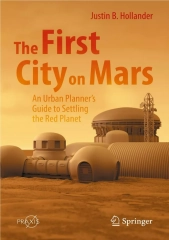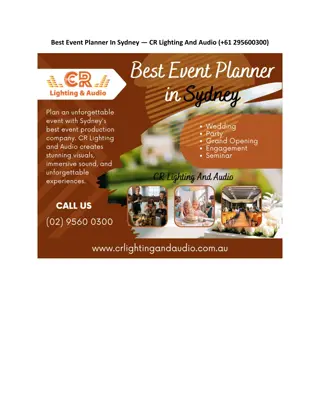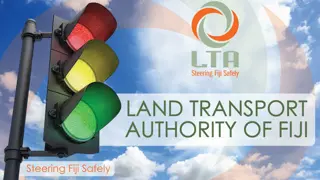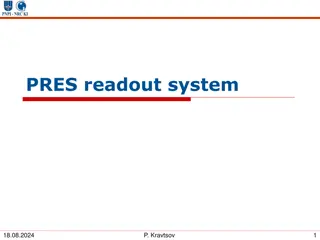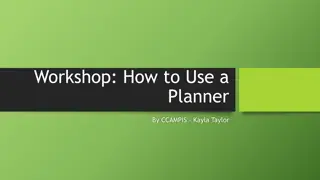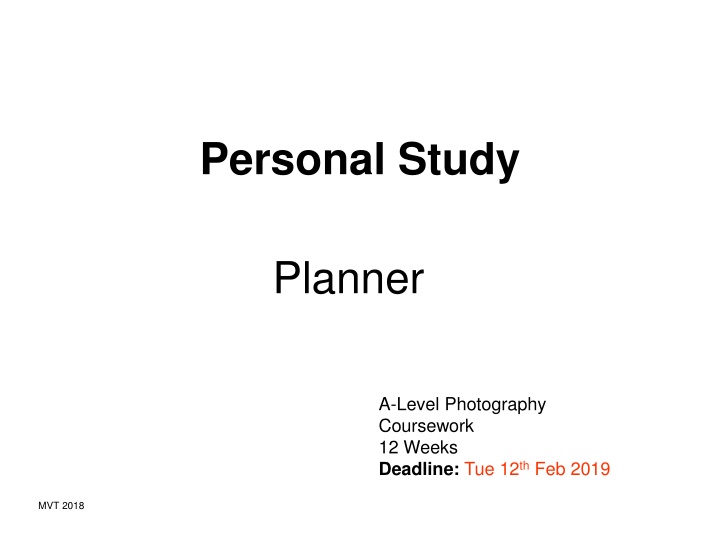
A-Level Photography Coursework: Personal Study Planner and Methodology of Analysis
Dive into the world of A-Level Photography coursework with a focus on Personal Study and learn how to critically analyze photographs. Understand the requirements, deadlines, and expectations for producing top-grade work in the field of photography.
Download Presentation

Please find below an Image/Link to download the presentation.
The content on the website is provided AS IS for your information and personal use only. It may not be sold, licensed, or shared on other websites without obtaining consent from the author. If you encounter any issues during the download, it is possible that the publisher has removed the file from their server.
You are allowed to download the files provided on this website for personal or commercial use, subject to the condition that they are used lawfully. All files are the property of their respective owners.
The content on the website is provided AS IS for your information and personal use only. It may not be sold, licensed, or shared on other websites without obtaining consent from the author.
E N D
Presentation Transcript
Personal Study Planner A-Level Photography Coursework 12 Weeks Deadline: Tue 12th Feb 2019 MVT 2018
A-Level Coursework The A-level coursework consist of two modules, Personal Investigation (worth 72 marks) and Personal Study (essay worth 18 marks) which are interlinked and informed by each other All the work that you produced (both coursework and exam) in Yr 12 also contributes towards A-Level coursework overall equate to 60% of the total marks. From 1st of February 2018 you will begin your final component, Externally Set Assignment (Exam) that accounts for the remaining 40% of the combined A-level Photography marks
What is a Personal Study? The aim of this unit is to critically investigate, question and challenge a particular style, area or work by artists/ photographer(s) which will inform and develop your own emerging practice as a student of photography. The unit is designed to be an extension of your practical work in your Personal Investigation module where the practical informs and develops the theoretical elements and vice versa of your ongoing project. Your Personal Study is a written and illustrated dissertation, including a written essay (1000-3000 words) and a photographic body of work (250- 500 photos) with a number of final outcomes produced from your Personal Investigation unit. This year you have to make a photo book, either online using Blurb or by hand using traditional book binding techniques, which you design to include both your essay and a final selection and sequence of your photographs produced as a response to your chosen theme of POLITICAL LANDSCAPES In addition, we are also expecting that those of you who want to go above and beyond to achieve top grades will produce a mini film/ pod cast with sound and images based on the same narrative as above
What it says in the syllabus (Edexcel) Essential that students build on their prior knowledge and experience developed during the course. Select artists work, methods and art movements appropriate to your previous coursework work as a suitable basis for your study. Investigate a wide range of work and sources. Develop your written dissertation in the light of your chosen focus from the practical part of previous coursework and projects. Establish coherent and sustainable links between your own practical work with that of historical and contemporary reference. Be aware of some of the methods employed by critics and historians within the history of art and photography. Demonstrate a sound understanding of your chosen area of study with appropriate use of critical vocabulary. Show evidence for an ongoing critical and analytical review of your investigation both your written essay and own practical work in response to research and analysis. Develop a personal and critical enquiry. Culminate in an illustrated written presentation.
METHODOLOGY OF ANALYSIS How to analyse a photograph critically Describing ~ FORM ~ What is here? What am I looking at? Interpreting ~ MEANING ~ What is it about? Evaluating ~ JUDGEMENT ~ How good is it? Theorizing ~ CONTEXT ~ Is it art? How does it relate to the history and theory of photography, art and culture? 1. 2. 3. 4. For further help on how to analyse a photograph critically see Powerpoint: How to analyse a photograph
Quotation and Harvard System of Referencing Use quotes to support or disprove your argument Use quotes to show evidence of reading Take notes when you re reading key words, concepts, passages etc. Write down page number, author, year, title, publisher, place of publication so you can list source in a bibliography Use Harvard System of Referencing see Powerpoint: Harvard System of Referencing for further details. For further help of how to construct your essay see Powerpoint: Personal Study + Essay structure
Monitoring & Tracking Sheet Slides to improve: Actions to take Complete by: Week 9: 5 12 Nov Personal Investigation & Contextual Studies Complete the following blog posts Personal Investigation: Lesson Time (Mon, Tue, Thurs, Fri) Save shoots in folder and import into Lightroom Organisation: Create a new Collection Set: Political Landscape and create a Collection from each shoot underneath the set. Editing: select 8-12 images from each shoot. Experimenting: Adjust images in Develop, both as Colour and B&W images appropriate to your intentions Export images as JPGS (1000 pix) and save in a folder BLOG Create a Blogpost with edited images and an evaluation, explaining what you focused on in each shoot and how you intend to develop your next photoshoot. Make references to artists references, previous work, experiments, inspiration etc. Further experimentation: Export same set of images from Lightroom as TIFF (4000 pixels) Experimentation: demonstrate further creativity using Photoshop to make composite/ montage/ typology/ grids/ diptych/triptych, text/ typology etc appropriate to your intentions Design: Begin to explore different layout options using Indesign and make a new zine/book. Set up new document as A5 page sizes. Make sure you annotate process and techniques used and evaluate each experiment. add new material Doc: Robert Capa or Joe Rosenthal Tab: Tom Hunter Max Pinchers speculative documentary me; Seaflower Venture Photographic Task: Contextual study Homework Photography and Truth ANALYSIS: Choose one image from case studies listed below that questions the notion of truth regarding the photographic image and its relationship with reality and explain why. PHOTO-ASSIGNMENT:Based on your chosen theme of Political Landscape make two images, one that you consider truthful and one that is not.
Monitoring & Tracking Sheet Slides to improve: Actions to take Complete by: Week 10: 19 26 Nov Personal Study Complete the following blog posts Make a separate blog post for this Mon 19 Nov - Reviewing and reflecting: From your Personal Investigation write an overview of what you learned and how you intend to develop your Personal Study essay. Describe which themes, artists, approaches, skills and photographic processes/ techniques inspired you the most and why. Include examples of current experiments to illustrate your thinking. Lesson 1 - Contextual Study: Research artists/photographers, methods, art movements and historical context appropriate to your Personal Study essay Lesson 2 - Academic Sources: Find 3-5 different texts to support your academic study from a variety of sources (books, articles, journals, magazines, websites, Youtube/films etc.) Lesson 3 - Essay Question: Think of a hypothesis and list possible essay questions Homework - Independent Study: Begin to read, make notes, identity quotes and comment to construct an argument for/against. Explain how you intend to respond creatively to your artists references and further experimentation and development of your photographic work as part of your Political Landscape project. Lesson 4 - Essay Plan: Make a plan that lists what you are going to write about in each paragraph Lesson 5 Essay Introduction: Begin to write a draft introduction and upload to the blog end of your Mock Exam; Tue 21 Nov (13C) and Wed 22 Nov (13A & 13D)
Monitoring & Tracking Sheet Slides to improve: Actions to take Complete by: Week 12-13-14-15: 26 Nov 19 Dec Political Landscape Complete the following blog posts Political Landscape: Lesson time (Mon, Tue, Thurs & Fri Bring images from new photo-shoots to lessons and follow these instructions Save shoots in folder and import into Lightroom Organisation: Create a new Collection from each new shoot inside Collection Set: Political Landscape Editing: select 8-12 images from each shoot. Experimenting: Adjust images in Develop, both as Colour and B&W images appropriate to your intentions Export images as JPGS (1000 pixels) and save in a folder: BLOG Create a Blogpost with edited images and an evaluation; explaining what you focused on in each shoot and how you intend to develop your next photoshoot. Make references to artists references, previous work, experiments, inspiration etc. Further experimentation: Export same set of images from Lightroom as TIFF (4000 pixels) Experimentation: demonstrate further creativity using Photoshop to make composite/ montage/ typology/ grids/ diptych/triptych, text/ typology etc appropriate to your intentions Design: Begin to explore different layout options using Indesign and make a new zine/book. Set up new document as A5 page sizes. Make sure you annotate process and techniques used and evaluate each experiment Essay: Lesson time (Wed) Complete draft version of your introduction and upload to the blog no later than Wed 19 Dec.
TRACKING SHEET: SPRING TERM - DEADLINE MON 11 / TUE 12 FEB Sections to complete Week 16: 8 14 Jan Edit images and complete essay introduction Slides to improve: Actions to take Complete by: Political Landscape: Lesson time (Mon, Tue, Thurs & Fri) Bring images from new photo-shoots to lessons and follow these instructions Save shoots in folder and import into Lightroom Organisation: Create a new Collection from each new shoot inside Collection Set: Political Landscape Editing: select 8-12 images from each shoot. Experimenting: Adjust images in Develop, both as Colour and B&W images appropriate to your intentions Export images as JPGS (1000 pixels) and save in a folder: BLOG Create a Blogpost with edited images and an evaluation; explaining what you focused on in each shoot and how you intend to develop your next photoshoot. Make references to artists references, previous work, experiments, inspiration etc. Prep for photobook design: Make a rough selection of your 40-50 best pictures from all shoots. Make sure you have adjusted and standardised all the pictures in terms of exposure, colour balance. Further experimentation: Export same set of images from Lightroom as TIFF (4000 pixels) Experimentation: demonstrate further creativity using Photoshop to make composite/ montage/ typology/ grids/ diptych/triptych, text/ typology etc appropriate to your intentions contrast, brightness and produced a duplicate a set in B&W. Make sure you annotate process and techniques used and evaluate each experiment Essay: Lesson time (Wed) Complete Paragraph 1 and upload to the blog no later than Mon 14 Jan.
TRACKING SHEET: SPRING TERM - DEADLINE MON 11 / TUE 12 FEB Slides to improve: Actions to take Complete by: Sections to complete Week 17: 14 - 21 Jan: Research / deconstruct photo book Political Landscapes: READ these texts to better understand how to identify a narrative and understand the design process of photobook making. Colin Pantall: Identifying the Story: Sequencing isn't narrative Extension: Here are a serious blog post by Photobook critic, Joerg Colberg which consider the many aspects of photobook making: The Forms an Functions of Photobooks Research a photo-book and describe what story/narrative the book is telling - its subject-matter, genre, style, approach etc. Who is the photographer? Why did he/she make it? (intentions/ reasons) Who is it for? (audience) How was it received? (any press, awards, legacy etc.) Deconstruct the narrative, concept and design of the book such as: Book in hand (how does it feel?0, paper and ink, format, size and orientation, design and layout, rhythm and sequencing, structure and architecture, narrative. title, images and text Essay: Lesson time (Wed) Complete Paragraph 2 and upload to the blog no later than Mon 21 Jan.
TRACKING SHEET: SPRING TERM - DEADLINE MON 11 / TUE 12 FEB Slides to improve: Actions to take Complete by: Sections to complete Week 18: 21 28 Jan: Final edit Political Landscape Using Lightroom make a rough selection of your 40-50 best pictures from all shoots. Make sure you have adjusted and standardised all the pictures in terms of exposure, colour balance, contrast, brightness and produced a duplicate a set in B&W. Write a book specification and describe in detail what your book will be about in terms of narrative, concept and design. Produce a mood-board of design ideas. Create a Blurb account and begin to make a layout and design photobook. Produce screen prints of layout ideas as you progress and add to Blog for further annotation, commenting on page layout/ narrative/ sequencing/ juxtaposition of pictures. Essay: Lesson time (Wed) Complete Paragraph 3 and upload to the blog no later than Mon 28 Jan.
TRACKING SHEET: SPRING TERM - DEADLINE MON 11 / TUE 12 FEB Slides to improve: Actions to take Complete by: Sections to complete Week 19-20: 28 Jan 12 Feb MOCK EXAM one full day in class, Mon 11 and Tue 12 Feb Design Photobook Political Landscape Using Lightroom make a rough selection of your 40-50 best pictures from all shoots. Make sure you have adjusted and standardised all the pictures in terms of exposure, colour balance/ B&W, contrast/brightness etc. Decide on format (landscape, portrait) size and style of your photo- book. Begin to design your photo book, considering carefully, narrative, sequencing, page spreads, juxtaposition, image size, text pages, empty pages, use of archival material etc. At the end of your photo book, add your illustrated essay including title, any captions (if needed), bibliography, illustrations of artists work (incl data) and images of your own responses. Think carefully about font type, size and weighting. Produce screen prints of layout ideas as you progress and add to Blog for further annotation, commenting on page layout/ narrative/ sequencing/ juxtaposition of pictures. Select a set of 5-6 photographs as final outcomes and evaluate explaining in some detail how well you realised your intentions and reflect on what you learned in your Personal Study. Save final outcomes in our PRINT folder by 15:00 end of your Mock exam in a high-resolution (4000 pixels on the long edge.) Make sure all blog posts are finished including, research, analysis, experimentation, annotation and an evaluation of final outcomes. DEADLINE: END OF MOCK EXAM Essay: Lesson time (Wed) Complete Conclusion, proof read, make corrections and upload to the blog no later than Mon 4 Feb.

